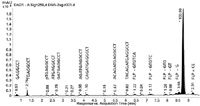Fast Impurity Profiling of Synthetic Oligonucleotides
Recognition of DNAs and RNAs wide range of biological actions has driven modern biopharmaceutical research into the therapeutic value of oligonucleotides.
Moritz Wagner, Zoltan Timar, Edgar Naegele, and Gordon Ross, Agilent Technologies
Recognition of DNAs and RNAs wide range of biological actions has driven modern biopharmaceutical research into the therapeutic value of oligonucleotides. They are prepared by chemical synthesis and while their size and biological function vary, the requirement for their quality control is the same. The quality control of synthetic oligonucleotides requires a high resolution chromatographic method in order to separate the desired oligonucleotide from fragments generated as a consequence of the automated synthesis and post synthetic process. Liquid chromatography coupled to UV and MS detection allows both relative quantification of the main component and its impurities (UV) and their identification via accurate mass determination (MS).

Figure 1: Detection of a synthetic oligonucleotide and its byproducts with a DAD at 259 nm, 2 µg on-column. The annotations show both the peak area percent and base sequence.
Results and Discussion
The main component, together with its by-products, was detected by UV absorbance at 259 nm. Impurities could be determined down to 0.2% (Figure 1). The base sequences were identified from their accurate mass as discussed below and is annotated. Figure 2 demonstrates that the UV (259 nm) response was linear over the range 160 pg/µL to 100 ng/µL (3.2 ng to 2 µg on-column) and the LLOQ was 160 pg/µL with S/N = 13. This was sufficient to provide quantification of the desired oligonucleotide.

Figure 2: Calibration curve of full length product (FLP) (UV 259 nm) (Insert: response obtained for the LLOQ 160 pg/µL).
The Full Length Product (FLP): 5'-d(GTGTCAGTAC-AGATGAGGCCT)-3', elutes at 8.6–8.8 min and different charge states can be detected. The calculated average mass using maximum entropy deconvolution was 6486.28 (Figure 3) and the monoisotopic mass calculated by resolved isotope deconvolution was 6483.108. It was possible to confirm the mass of the main product and to assign the impurities as shown in Figure 1.

Figure 3: Maximum Entropy deconvoluted mass spectrum of FLP 5'- d(GTGTCAGTACAGATGAGGCCT)-3', calculated average mass 6486.203 a.m.u.
Conclusion
This application demonstrates the separation of a crude synthetic oligonucleotide mixture after synthesis and final cleavage from the solid support. The Agilent 1290 Infinity LC System coupled with the Agilent 6530 Accurate-Mass QTOF-MS System can be used to simultaneously quantify and identify impurities down to lower nanogram levels and relative levels of 0.2% of the main compound. While UV detection allows quantification down to an LLOQ of 3.2 ng on-column, the accurate mass measurement allows the highly accurate determination of the average and monoisotopic mass and the base sequence of the synthesized oligonucleotide and process-related impurities.
Agilent Technologies
2850 Centerville Road, WIlmington, DE 19808
tel. (800) 227-9770, fax (302) 633-8901
Website: www.agilent.com

The Benefits of Custom Bonded Silica
April 1st 2025Not all chromatography resins are created equal. Off-the-shelf chromatography resins might not always meet the rigorous purification requirements of biopharmaceutical manufacturing. Custom bonded silica from Grace can address a wide range of separation challenges, leading to real performance improvements. Discover more about the latest innovations in chromatography silica from Grace, including VYDAC® and DAVISIL®.
5 Things to Consider When Selecting a Chromatography Silica
April 1st 2025Particularly in the pharmaceutical industry, drug purity isn’t just a goal – it’s essential for achieving safety, stability and efficacy. However, purification is easier said than done, especially with challenging molecules like DNA and RNA “oligonucleotides,” due in large part to their diversity and the range of impurities that can be generated during production. Enter DAVISIL® chromatographic silica, with a wide range of pore diameters and particle sizes to meet your specific application, performance and sustainability requirements. Before you choose the chromatography resin for your next purification application, take a look at these 5 considerations.
Automating Protein Purification: Efficiency, Yield, and Reproducibility
March 27th 2025Recent advancements in automated protein purification stress the importance of efficiency, scalability, and yield consistency. This eBook compares different purification platforms, highlighting their impact on downstream applications and demonstrating how automation enhances throughput and process control.
MilliporeSigma: Ultrapure Water for Sensitive LC-MS Analysis of Pesticides
March 25th 2025The aim of the study was to illustrate the efficiency of Milli-Q® water purification systems in eliminating pesticides from tap water, thereby producing and delivering reliable and consistent-quality ultrapure water suitable for pesticides analysis















